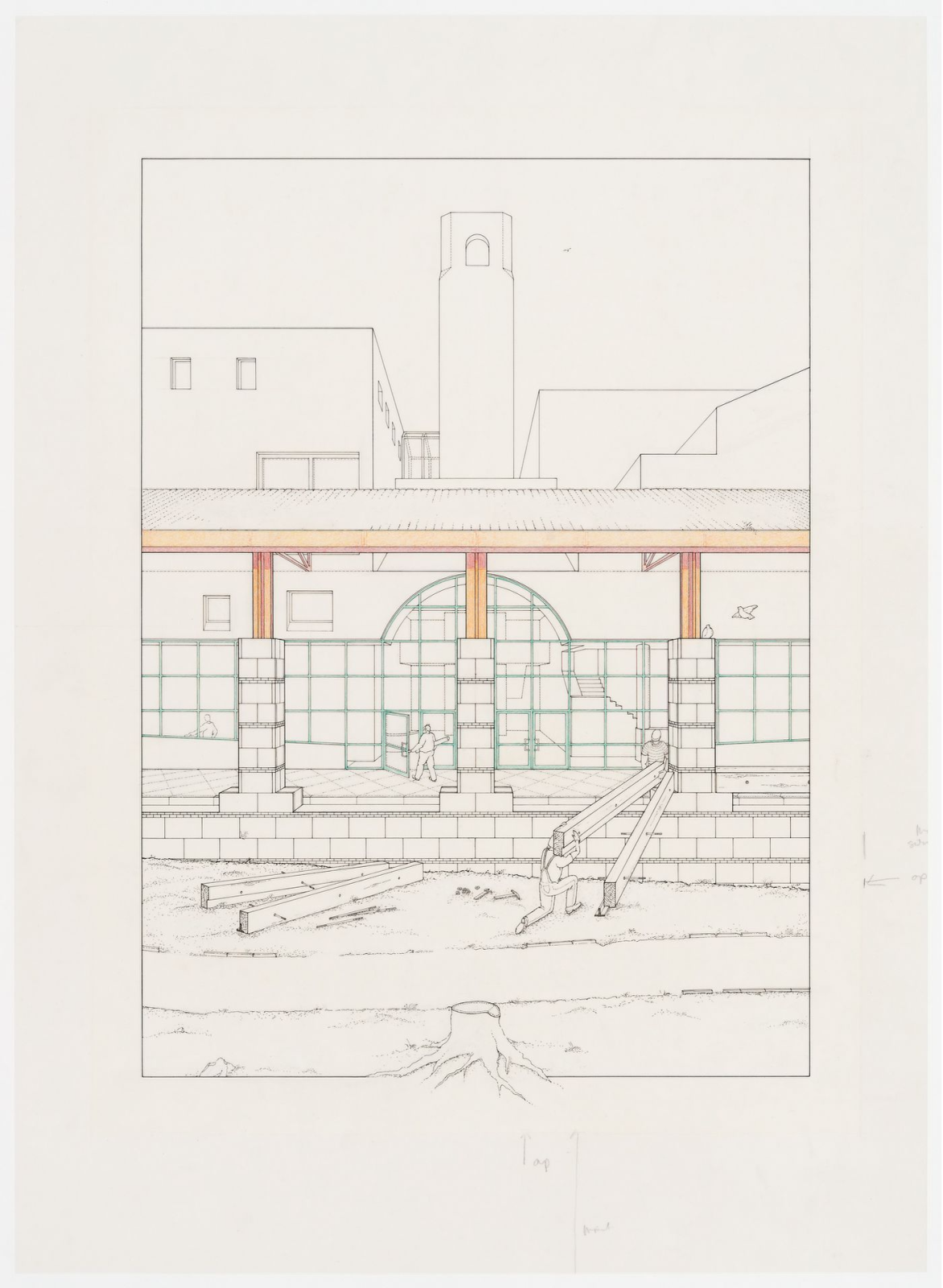-Robin Evans, "Architectural Projection." Architecture and Its Image, edited by Eve Blau & Edward Kaufman, MIT Press, 1989, pp. 19
* * *

and Plan Detail of Draughtsman Making a Perspective Drawing of a Woman, Courtesy of Author, 2022.
(click any image to enlarge)
The popular image of an architectural drawing is generally quite far from that of a comic. If you were to ask a random, generous smattering of your neighbors to produce one (provided you didn’t live somewhere too trendy) you might imagine the sorts of images they’d collectively conjure. Somebody might offer a set of plans - calling to mind heavy rolls of light-blue vellum, scrawled with constipated technical line work and framed between all manner of scales, grids, and carefully-lettered notations. Alternatively, someone snarkier might offer the mythical, crumpled napkin sketch whose delicate lines boast an economy their lone-genius author never flies in. These two images, detached as they may be from reality, articulate the representational logic embedded in the two most important types of architectural drawing - what we call projected drawings and diagrams, respectively.
The basic principle behind the former is that, when we draw in projection, we imagine a series of linear rays projecting from a described object to a planar drawing surface. Through the sequential, panelled aggregation of these projections in various orientations (plan, section, etc.) we arrive at an understanding of the virtual image of the described whole. That is to say that the majority of our understanding of the subject doesn’t come from the individual drawings, but from the inferences we make in what happens between them. Sound familiar? It is the fundamental operation of comics! On the other hand, the idea behind the diagram is one of distillation - how can we reduce the resolution of a drawing until it communicates something complex more efficiently? In other words, cartooning. In both cases, I’d venture that even the most caricatural vision of what it is that architects draw rarely escapes the umbrella of comics - and that a burgeoning interest among young architects in taking comics seriously is more or less a natural product of what is already a long-running parallel practice between the two disciplines.

and Chandler North Building, Department of Chemistry, Columbia University, New York, New York: perspective of building in decay, James Stirling, ca 1978-1983.
An important misconception around architectural drawing is that the subjects it describes are typically staid and permanent. Rather like cartoonists, when we talk about the virtual image that a projected drawing describes—the “thing”—the state of being drawn could more accurately be characterized as the predicament a thing finds itself in. This is true both in the realm of so-called paper architecture, that is architecture without a relationship to a built ambition, and outside of it. The late Norm Macdonald had a bit that went something like: “The world’s youngest man, Declan McAllister, was just born-- oh correction, the world’s youngest has-- oh no, not her either.” It is by this same logic that even the most static and geometrically descriptive drawing has to it an embedded relationship to time. It is impossible to capture a place as it is and will always be when the quality we are looking to represent is time-contingent. When we talk about projecting a descriptive image, the ray fired from object to panel, like starlight, takes its time getting there - and it presents an image that is as much a fiction as the projected drawing of some future scheme. In the above drawings for two academic buildings by the British architect James Stirling, he renders them amid processes of construction and destruction. When read in sequence with descriptive plans and sections, we begin to project not just how a space might look or feel, but when it might have those qualities. Whether reading a Nancy strip or a plot of plans and sections, the multiple drawing combines the familiar visual mechanics of written language and the more vague pleasure of having your own view to an event transpiring in space.

Many cartoonists have addressed this principle with a nuance that still escapes architects - but of interest to me, prominent figures in comics-about-space-time like Chris Ware or Richard McGuire are slowly emerging as major references within departments of architecture. This piqued interest seems almost comically late given how long architects have ruminated on filmic montage, but better that than never. I suspect that part of this trend might be linked to a shifting perception of sites as unstable and a resultant interest in ephemeral qualities of space. An architect seeking out drawing standards for a figure in perpetual flux might just be best served by looking, for example, to the shifting mesas and vast vagueness of George Herriman’s Coconino County rather than a traditional precedent. Reading architectural drawings seems to me to rely on the same naïve assumption that comics do for the reader - that is, that images presented in a set relate to each other in an earnest way, and that by their juxtaposition they produce something meaningful. In the case of the above strip, the relatively mute architecture of Offisa Pup’s jail plays against contextual transformations in both space and time. The reader of an architectural drawing set anticipates consistent space, but rarely demands substantive evidence of that consistency - much in the same way that we happily understand Krazy and Ignatz to occupy the space of the desert, even as the details of its form constantly shift. The contingency of the detail is rarely audited, and not because the reader is passive, but more out of an eagerness to link fragments, materials, elements and moments together.

There is doubtless a long line of architects who have understood this relationship with comics, even if they haven’t named it as such, and engaged sequential drawing in proto-comic formats from the tapestry to the triptych. However, leaning specifically into the representational genre of the comic is a relatively recent phenomenon that might be first attributed to radicals of the 1960s like Superstudio, Ant Farm, or Archigram. Frankly, tracing that lineage to the present is beyond the scope of this article - but I think it is worth pointing to work like Thom Mayne’s (submitted, no doubt to a very confused inspector) Flores Residence Construction Details above, just to make clear that formal innovations like the deployment of gutters, non-linear readings, and scalar shifts between panels are graphic strategies which architects have deployed long before, say, alternative comics became a trendy aesthetic to appropriate. I think that there is always a healthy amount of skepticism within the comics community when other artists (and “applied artists”) try to establish ties, and it is not for me to decide what is and isn’t extractive or honest - but I think it is worthwhile for comics people to see what is out there in architecture and vice versa. I hope to highlight here a very much non-comprehensive selection of the typologies of what I call “Archi Comics” (oldies might know them as PEP, or Proceeding Etchings of Places), as a way of identifying trends that run parallel to contemporary comics and in the hopes of bringing attention to comics work happening outside of traditional formats.

Bernard Tschumi’s The Manhattan Transcripts was a book project that was early to take up the issue of the disconnect between objects and events - positioning that disjunction as an architectural conflict. Here, the form and function dialogue is complicated by the introduction of time. Tschumi’s most overt reference in the piece is to the structural diagramming of filmmaker Sergei Eisenstein - but formatted as a book, the project presents moments less as film stills than panels situated in the hyperframe of a page. In the example of the above page, the gutter along the top right takes on structure and fenestration as if to call attention to the fact that the architecture occurs as much between as within panels. True to its structuralist roots, the project breaks down the virtual image of an architectural whole into rows and columns of panelled diagrams that describe various qualities and conditions of an event taking place in space. Graphically, it ranges from photo negatives to the Xs and Os of a football coach’s dry erase board.
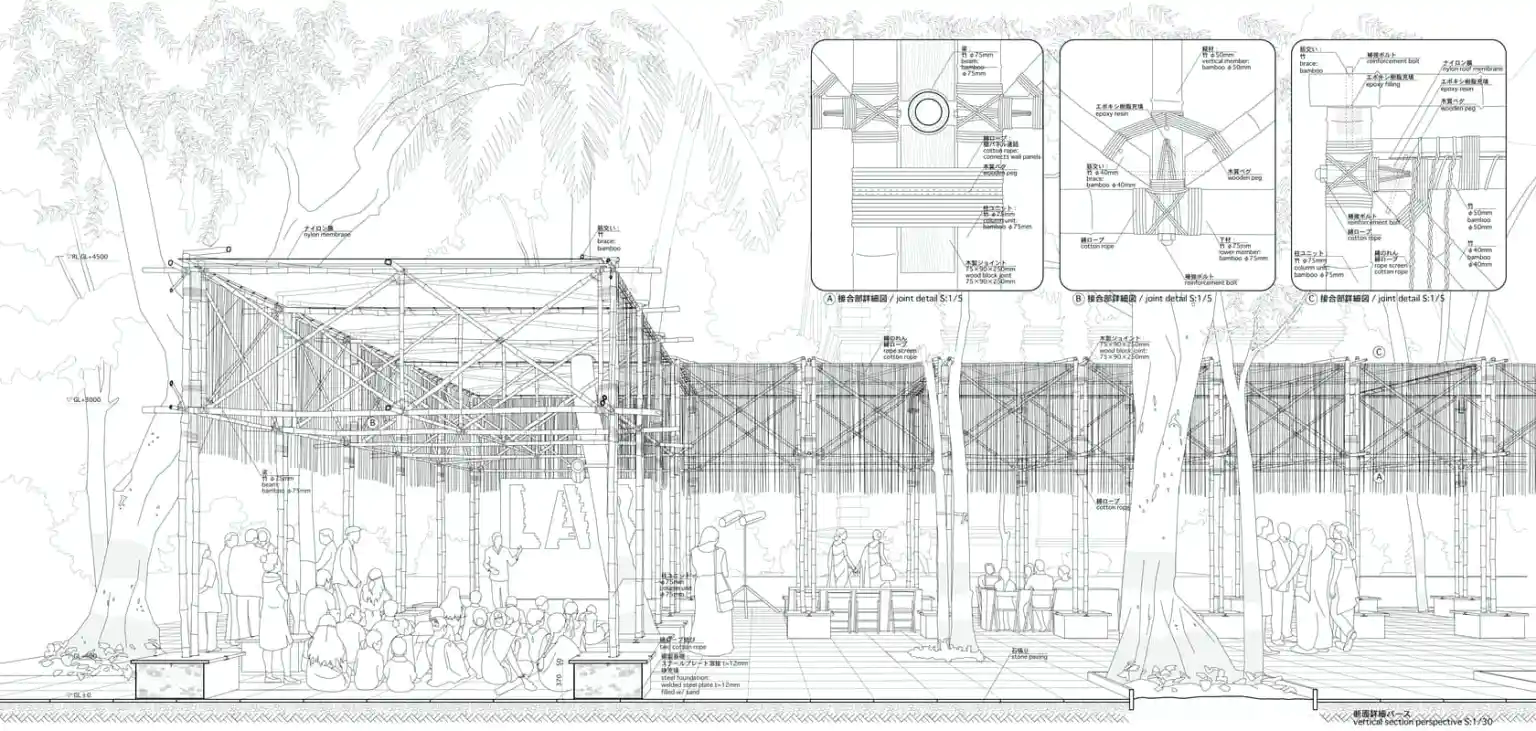
In this book project, Atelier Bow-Wow developed a borderline scientific notational style to document a series of their smaller-scale built projects. The drawings intentionally paired perspectives with magnified, panelled construction details such that the architecture could be read less as a singular imagined object than as a relationship between humans and space playing out at a range of scales. The meticulous labelling calls to mind bad political cartoons, or at least early ones. Architectural drawings have always featured an interplay between text and image - but there are growing pains associated with new genres of representation, and the adoption of new graphic standards can feel clunky. Newspaper comics once featured numbered panels and excessively expository narration too. The drawing style is so bare and consistent that any elemental hierarchy within the image has to be assigned by panel and text - this is in line with the authors’ stated aim to present events and space similarly to achieve a certain documentary earnestness.

It would be difficult to survey comics in architecture without mention to Jimenez Lai and Bureau Spectacular - the practice mediates architecture and comics somewhat bilaterally, in the tradition of Joost Swarte. While probably better known in comics for the graphic novel Citizens of No Place (Princeton Architectural Press, 2012), Bureau Spectacular has taken on comic formats even in built projects. This 52-foot installation was conceptualized as a 1:1 model of a fictional apartment building. The pavilion plays off of the physical space occupied by speech bubbles and panels as a way of developing a stacking logic for a series of interior niches. The living section operates at a scale somewhere between those iconic splash pages of Reed Richards’ Baxter Building and the bisected head pages of The Numskulls. Translating the comic profile into built form also challenges the sectional depth and structure of the 2D panels we often take for granted.
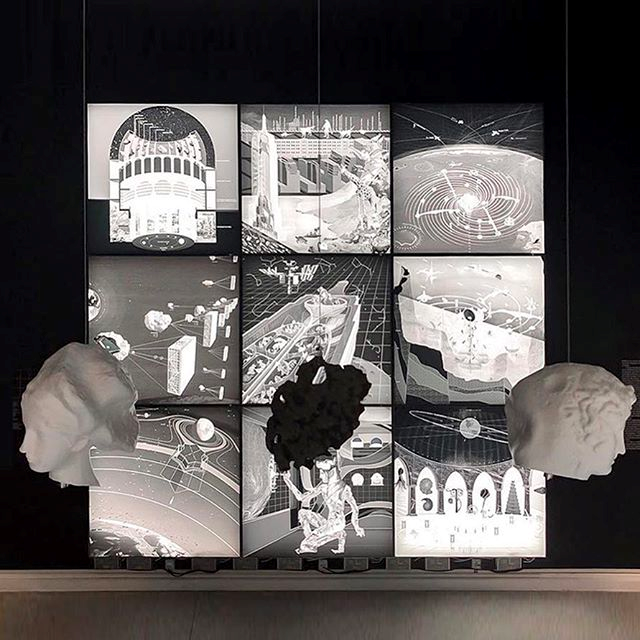
Design Earth is a practice that leverages speculative architectural projects to comment on the climate crisis. In the case of this installation, Cosmorama, they present a series of what they call "geostories" in a nine-square grid - describing three fictive projects that explore humanity’s relationship to the cosmos. As in Bureau Spectacular’s project, the realization of these individual panels in space starts to challenge assumptions we make about how images relate to one another. Between the panels, and depending on the direction of your reading, incomprehensibly vast scalar shifts take place and the viewer is repeatedly forced to reorient and reinterpret. In terms of an interplay with text, there is a sort of 10th panel in the form of a long text laying on the floor in front of the grid - which, somewhat inconveniently, requires the reader to repeatedly retreat from the images to understand what it is they are encountering.
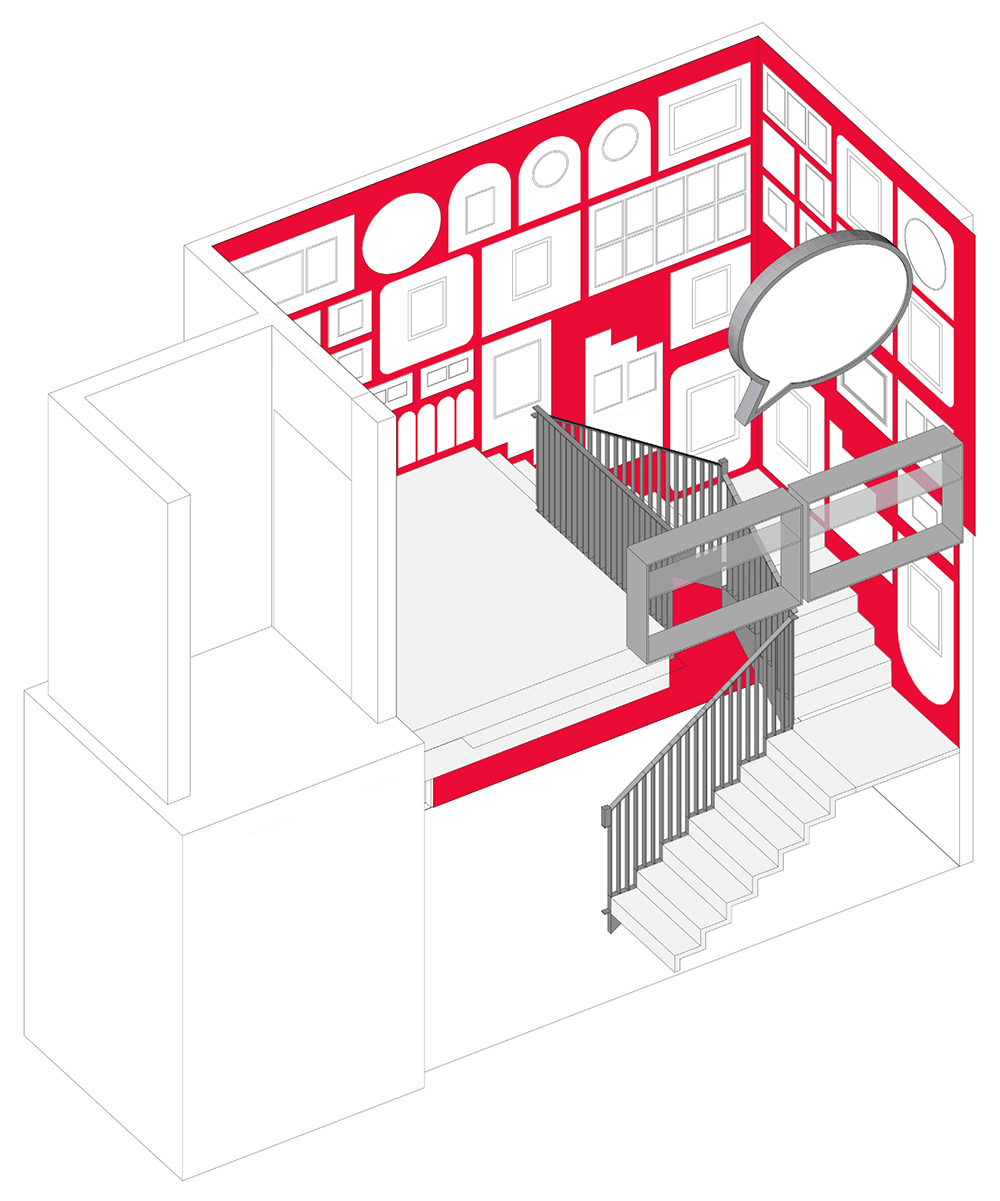
Sam Jacob is in the rare position of having worked on multiple comics-based built projects, having also designed the Beano: The Art of Breaking the Rules exhibition. For this design, the studio invokes the graphic language of comics as a mechanism for dividing interior space and imbuing typically-mundane details with playfulness. Much of the translation from the 2D page to the built realm takes place by extruding the profiles of things like panels, thought bubbles and so on in an iconographic way. More interestingly, the studio notes: “Just as in cartoons, physical things don’t behave as one might expect.” The notion that a comics object is imbued with a certain unpredictability is one that feels consistent across the projects discussed. Some of the scalar and sequential vagueness baked into the comic form seems to translate into the real environment in a productive way. Jacob is also well-known for paper projects that deploy comic systems and their misreadings to impressive effect - as in the Pasticcio Tower and Empire of Ice Cream.
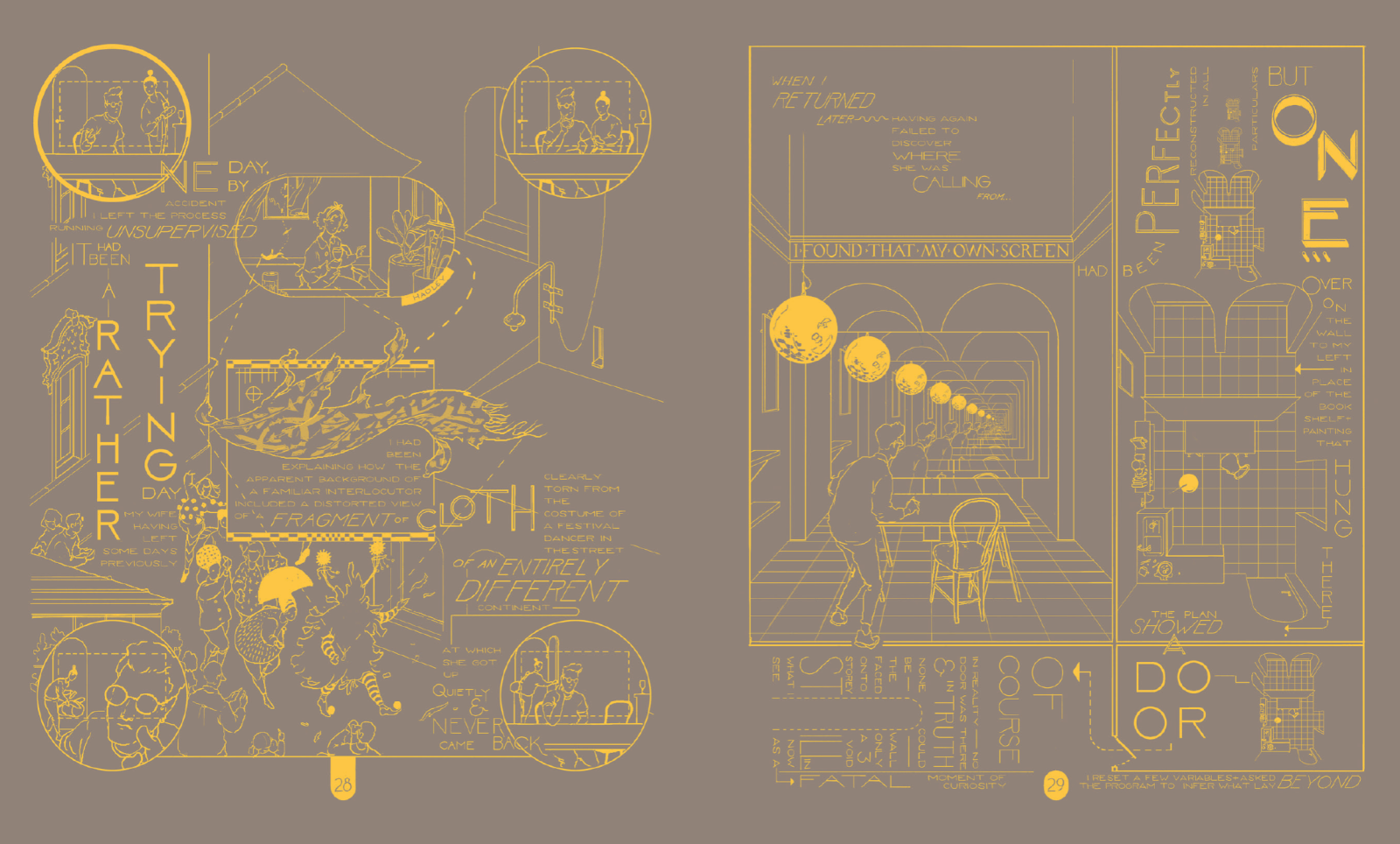
Lastly, while I have tried to highlight things happening in less familiar formats and that fit the definition of a comic more loosely, I want to stress that there are also architects out there producing good, capital-C comics work. Anna Mill & Luke Jones are designers who, by their own account, “work together on comics and stories about humans, technology and the future.” They have produced a few comics—most notably the visually stunning Square Eyes—and to my eye strike the best balance among Archi Comic artists between taking interesting risks with spatial concepts as they relate to the comics format without becoming mired in inaccessible theory and jargon to the point that things become unfun. Their drawing is exuberant and rich and has a Geof Darrow-esque intensity that is pleasantly offset by carefully composed layouts. Specious Spaces demonstrates an interplay between projected architectural drawings and the comic format that makes me excited for the future of both.
* * *

Archi Comics seem a natural form for a discipline concerned with sequential storytelling, but the root cause of their present proliferation isn’t entirely clear. To conclude, I would offer up a few possible pathologies - the first being that comics enjoy a new degree of respect as a medium and position in the popular consciousness. Much in the same way that the new generation of independent comic artists seem to have largely shed the comics-as-low-culture chip on the shoulder of their predecessors, this generation of architects did not grow up with much stigma attached to unconventional drawing modes.
While low-effort fumetti like BIG’s Yes is More (Taschen, 2009) pay relatively shallow lip service to comics, it is easy to see why, as comics enter the mainstream, a practice might try to cash in by inviting visual association with something coded as countercultural (although I am not sure that there is anything more decidedly orthodox than capes iconography at this point). To read this adoption less extractively, architects are typically picky readers who process and appropriate theory from other silos at a slow clip. For a figure like Bernard Tschumi, who has famously and enthusiastically engaged so-called lowbrow media genres of representation like ad copy, we could imagine that he might have found just as many apt references in comics (particularly as a French-speaker) as in film, had they enjoyed the same robust theorization at the time he produced much of his comics work. Architects are also voracious consumers and recyclers of precedent work - which is to say, we can reasonably expect more Archi Comics to appear as explicitly spatial comics projects become more visible and ctrl+c-able.
Another possibility still is that comics’ exaggeration of the sequential operation of a drawing set is a sort of aesthetic response to the emergence of new technologies in architectural representation. As digital building information modelling gradually transitions towards live representations of virtual objects, like Revit models, the representational drawing set is afforded less responsibility and might become free to take on more inventive and impractical formats. Alternatively, a profession full of individuals who pursued architecture because their guidance counsellors heard that they liked to draw might need a new expressive outlet when their actual practice approaches rote data entry. Whatever the reason more architects are turning to comics, that it might provide a more accessible venue for a broader public to participate in projecting narratives around space and our built environments can only be a good thing.


